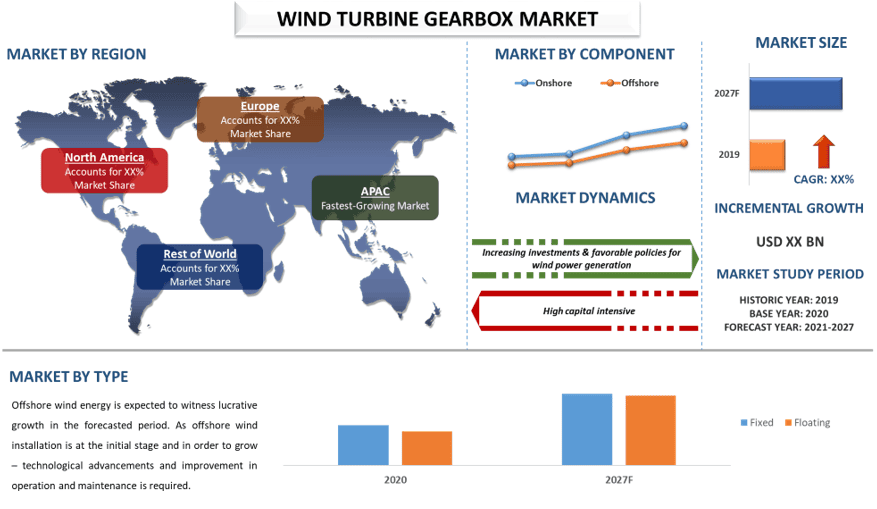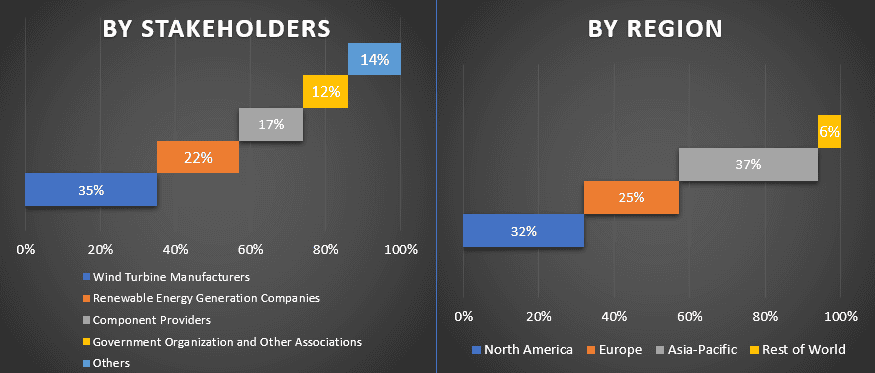
由于对可再生能源发电的电力需求激增,导致全球风电行业呈指数级增长。此外,2020-21 财年新增装机容量 93 吉瓦,使全球累计风电容量达到 743 吉瓦。此外,通过技术创新和规模经济,全球风电市场在过去十年中规模增长了近四倍,并已成为全球最具成本竞争力和弹性的电力来源之一。2020 年,创纪录的增长是由中国和美国(全球最大的两个风电市场)的装机容量激增推动的,这两个市场占全球风电总容量的一半以上。
根据全球风能理事会 (GWEC) 市场情报部门的预计,未来五年内将新增超过 469 吉瓦的陆上和海上风电容量——根据目前的政策和项目储备,到 2025 年,每年将新增近 94 吉瓦的装机容量。
随着电力需求的增长,风能以其高效率和不断下降的成本构成,正以极具影响力的速度增长。除此之外,与其他可再生能源相比,它的维护成本较低。此外,要实现净零排放,需要许多部门采取大胆行动,风能将成为绿色复苏的基石之一,在加速全球绿色能源转型方面发挥重要作用。
绿色风能理事会 (GWEC) 预计,到 2025 年,即未来五年内将新增超过 469 吉瓦的陆上和海上风电容量。随着中国风力涡轮机装机容量的爆炸性增长,亚太地区继续在全球风电发展中占据领先地位,其在全球市场中的份额在 2020 年有所增加。 因此,预计全球风力涡轮机齿轮箱市场在预测期内将以约 27% 的复合年增长率增长。
报告中提出的见解
“在部署方面,海上类别在预测期内将见证更高的复合年增长率”
根据部署情况,市场分为陆上和海上。其中,海上类别在预测期内见证了更高的复合年增长率。由于需要减少碳排放、化石燃料枯竭、气候变化等因素,能源行业已明显转向可再生能源和绿色能源。 各国政府制定了各种政策来支持绿色能源倡议。 许多跨国公司正在采取措施减少其碳足迹,为建设更绿色的地球和可持续发展做出贡献。例如,挪威 Equinor 的目标是到 2050 年将其碳排放量减少一半。该计划的一部分是发展其可再生能源业务,特别是海上风电,该业务可能会在六年内达到 6,000 兆瓦,在 15 年内达到 16,000 兆瓦。
此外,对开发包括固定式和浮动式海上风电项目在内的可持续能源平台的投资激增将推动该技术的采用。低维护、减少人力需求和最小的土地占用是推动市场份额的一些突出因素。
“亚太地区将在预测期内主导市场”
预计亚太地区风力涡轮机齿轮箱市场在预测期内将见证指数级复合年增长率。推动增长的主要因素包括有利的政府政策、对风电项目投资的增加以及风能成本的降低,这导致风能采用的增加,从而对风能需求做出积极贡献。此外,海上风力涡轮机效率的技术进步和生产成本的降低预计将为亚太地区的市场参与者创造充足的机会。
由于政府政策的支持和原材料的易于获得,中国在 2020 年在全球风能市场中占据了重要的收入份额。中国引领了全球有史以来最大的风电容量增长。此外,还存在主要的涡轮机制造商和主要的海上风电项目。2021 年,中国风力涡轮机制造商明阳智能推出了 5.5 兆瓦的涡轮机,这是中国有史以来建造的第一个浮动式海上风电塔和涡轮机。
购买此报告的理由:
- 该研究包括经过认证的主要行业专家验证的市场规模和预测分析
- 该报告一目了然地对整体行业绩效进行了快速审查
- 该报告深入分析了重要的行业同行,主要侧重于关键业务财务、产品组合、扩张战略和最新发展
- 详细考察了行业中存在的驱动因素、制约因素、关键趋势和机遇
- 该研究全面涵盖了跨不同细分市场的市场
- 深入的行业区域层面分析
定制选项:
风力涡轮机齿轮箱市场可以根据要求或任何其他细分市场进一步定制。除此之外,UMI 了解到您可能有自己的业务需求,因此请随时与我们联系以获取完全符合您要求的报告。
目录
分析历史市场、评估当前市场以及预测风力涡轮机齿轮箱市场的未来是创建和分析全球主要地区风力涡轮机齿轮箱市场需求和销售额的三个主要步骤。进行了详尽的二级研究,以收集历史市场数据并评估当前市场规模。其次,为了验证这些见解,考虑了许多发现和假设。此外,还与行业价值链中的行业专家进行了详尽的初步访谈。在通过初步访谈对市场数据进行假设和验证后,我们采用自下而上的方法来预测完整的市场规模。此后,采用市场细分和数据三角测量方法来评估和分析与该行业相关的细分市场和子细分市场的市场规模。详细方法如下所述。
历史市场规模分析
步骤 1:深入研究二级来源:
通过公司内部来源(例如年度报告和财务报表、业绩演示文稿、新闻稿等)以及外部来源(包括期刊、新闻和文章、政府出版物、竞争对手出版物、行业报告、第三方数据库和其他可靠出版物),进行了详细的二级研究,以获取风力涡轮机齿轮箱市场的历史市场规模。
步骤 2:市场细分:
在获得风力涡轮机齿轮箱市场的历史市场规模后,我们进行了详细的二级分析,以收集主要地区不同细分市场和子细分市场的历史市场见解和份额。报告中包含的主要细分市场包括部署和类型。此外,还进行了区域层面的分析,以评估全球背景下对风力涡轮机齿轮箱市场的总体需求。
步骤 3:因素分析:
在获得不同细分市场和子细分市场的历史市场规模后,我们进行了详细的因素分析,以评估当前市场规模。此外,我们使用因变量和自变量(例如车辆拥有量的增长和医疗保健行业的技术进步等)进行了因素分析。分析了历史趋势及其对市场规模和份额的逐年影响。还对需求和供应侧情景进行了彻底的研究。
当前市场规模评估和预测
当前市场规模:根据上述 3 个步骤的可行见解,我们得出了当前的市场规模、市场中的主要参与者以及细分市场和公司的市场份额。所有必需的百分比拆分和市场细分均使用上述二级方法确定,并通过初步访谈进行了验证。
评估和预测:对于市场评估和预测,为包括驱动因素和趋势、限制以及利益相关者可获得的机会在内的不同因素分配了权重。在分析了这些因素后,应用了相关的预测技术,即自下而上的方法,以得出到 2027 年全球主要地区不同细分市场和子细分市场的市场预测。用于评估市场规模的研究方法包括:
- 该行业的市场规模,以价值(美元)以及全球主要地区对风力涡轮机齿轮箱市场的需求来衡量
- 市场细分和子细分的所有百分比份额、拆分和细分
- 风力涡轮机齿轮箱市场中按提供的产品划分的主要参与者。此外,这些参与者为在快速增长的市场中竞争而采取的增长策略。
市场规模和份额验证
初步研究:与主要意见领袖 (KOL)(包括主要国家/地区的顶级管理人员(CXO/VP、销售主管、营销主管、运营主管、区域主管、国家主管等))进行了深入访谈。然后总结了初步研究结果,并进行了统计分析以证明所述假设。来自初步研究的输入与二级研究结果相结合,从而将信息转化为可操作的见解。
不同地区主要参与者的比例

市场工程
采用数据三角测量技术来完成整体市场评估,并得出风力涡轮机齿轮箱市场每个细分市场和子细分市场的精确统计数据。在研究了部署和区域领域的各种参数和趋势后,数据被分成几个细分市场和子细分市场。
风力涡轮机齿轮箱市场研究的主要目标
该研究指出了风力涡轮机齿轮箱市场的当前和未来市场趋势。投资者可以从研究中进行的定性和定量分析中获得战略见解,以作为其投资决定的基础。当前和未来的市场趋势将决定市场在区域层面的整体吸引力,从而为行业参与者提供一个平台,以利用尚未开发的市场来获得先发优势。该研究的其他定量目标包括:
- 分析风力涡轮机齿轮箱市场当前和预测的市场规模(以价值(美元)衡量)。此外,分析行业不同细分市场和子细分市场的当前和预测的市场规模
- 研究中的细分市场包括部署和区域
- 明确分析风力涡轮机齿轮箱市场行业的监管框架
- 分析涉及各种中介机构的价值链,以及分析与该行业相关的客户和竞争对手行为
- 分析全球风力涡轮机齿轮箱市场当前和预测的市场规模。报告中分析的主要区域包括北美(美国、加拿大、北美其他地区);欧洲(德国、英国、法国、西班牙、欧洲其他地区);亚太地区(中国、印度、日本、澳大利亚、亚太其他地区);和世界其他地区。定义和分析风力涡轮机齿轮箱行业的竞争格局,以及市场参与者为在快速增长的市场中保持竞争力而采取的增长策略
- 深入研究该行业的区域层面分析
相关 报告
购买此商品的客户也购买了










